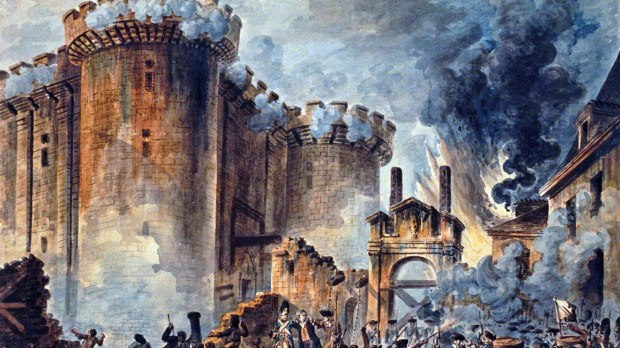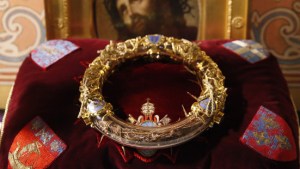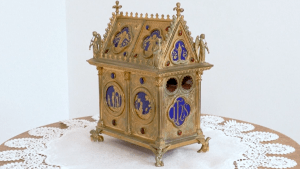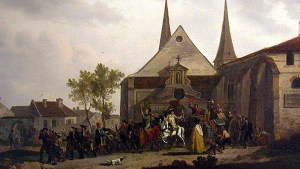To say that the French Revolution persecuted the Catholic Church is not entirely correct, or at least the claim must be qualified.
When we claim something like that we typically think that the revolutionaries wanted to build a secular society in which religious people would not have privileges or be relevant factors in public life; but that is not exactly true.
Rather, what took place during the revolution was the opening of a process in which the religions considered “historical” were to be replaced by a “state religion” with its own theological frame, officials, elites and privileges that would ensure, above all else, that citizens would be subject to the law in conscience and heart. The king would no longer be king, certainly not by the grace of God, because now the law, and only the law, is god, whatever it may say.
The Estates-General convened by Louis XVI in 1789 were divided into three orders: the clergy, the nobility, and the “third estate.”
The first two had 561 representatives (291 and 270, respectively) while the third estate, whose commissioners were elected by tax-paying males over the age of 25, had 578. The number was not significant, in principle, since the king wished to maintain the vote by estates and not by individuals.
The purpose of the convocation was to help the monarchy carry out reforms that could help improve the general situation of the country, which was mired in poverty and discouragement.
At first the clergy did not “bother”
The truth is that the clergy were not an obstacle to the initial reform policy. The clergy supported the measures, promoted by the third estate, which established the separation of powers, the frequent meeting of the Estates-General, their supremacy in the fixing of taxes, the recognition of individual liberties, etc., although only a quarter of its members wanted a complete revision of government by promoting a democratic revolution.
The majority of the clergy was in favor of a gradual reform and not of a revolutionary upheaval. Despite this moderate attitude, the storming of the Bastille on July 14 and the subsequent abolition of feudal privileges, most of which favored the Church, were not events that particularly alarmed the bishops and priests, who were more concerned with the results of the constitutional reform that had been initiated by a new Assembly.
Then the “Declaration of the Rights of Man and of the Citizen” promulgated religious freedom, reserving to the state the power to determine when opinions in matters of creed were incompatible with the law.
A short-lived freedom
On July 12, 1790, the “constitutional church” was established, which, in practice and through a rapid process of state fundamentalism, became the only creed accepted by the government.
This “church” had its own organization and functioning, decided by the state, and Catholic priests were offered the possibility of swearing their fidelity to the norms promulgated in matters of religion, disassociating themselves from obedience to their bishop and to Rome.
Unfortunately, and in spite of the determination of Pope Pius VI and the rebellion of the bishops (only four swore the new order) many priests, especially from the center of the country, joined the “lay church” and became political commissioners of the state in religious matters. The creation of this church was celebrated in the Campo de Marte, with the officiants dressed in tricolor vestments, in the style of the new national ensign.
Persecution of faithful clergy
The persecution against those who did not accept this situation was brutal. The “refractory” priests — those who remained Catholic — were persecuted, they could not celebrate sacraments or preach and, from March 18, 1793, if they were caught on French soil they had to be executed in less than 24 hours.
Many of them had their sentences commuted to an even worse fate in the infamous prisons of French Guiana. At the same time, communication was prevented between French Catholics and the pope, whose letters and documents could not be made known in the country without the approval of the legislative bodies.
Subsequent to the French Revolution, the Catholic Church suffered one of the worst persecutions in history. Children could not be baptized and communities could not celebrate the Eucharist. The sacraments could only be officiated on rare occasions and in secret.
In Brittany, the region that registered the greatest number of priests opposed to the new schismatic church, the faithful gathered in boats, far from the coast, or hidden deep in the region’s forests. Those who participated in such “illegal meetings” could be condemned to death as enemies of the state. In Brittany, about 120,000 Catholics were killed for religious reasons, slightly more than 15 % of the population.
Meanwhile, the revolutionary authorities determined by decree — at the instigation of Robespierre — the existence of the “Supreme Being” and “the immortality of the soul.” They instituted the celebration of “festivals of the Supreme Being” from 1794 onwards. Before that, temples to reason had already been created using former churches and synagogues. Citizens were forced to bind their conscience to a series of political and moral norms to the (otherwise changing) taste of the powers that be.
It was not, therefore, an attempt to eliminate religion or to repress the Catholic Church or to disrupt many of its sometimes extravagant privileges, but an effort to make the state the ultimate hierarch of individual conscience and the object of public devotion. It is very important to understand the role of religion in society, as well as to realize that the state cannot pretend to take the place of the Church, not even under the equivocal and abstract veil of the notion of “citizenship.”




